Cities around the world are becoming denser, with greater built form resulting in more hard surfaces and less green space. However, green roofs and walls can help traditional and contemporary architecture to be transformed into living architecture. Graeme Hopkins and Christine Goodwin report.
From our own lawn covered Parliament House, to the underground homes in Coober Pedy, living architecture is becoming a part of our iconic designs. And it's also a trend that will continue to grow as we face the issues of climate change, and the predicted increased temperatures which result in an urban heat island (UHI) effect. This is the storage of solar energy in the urban environment which is then released into the atmosphere, especially at night, as heat energy.
Benefits of green roofs
It has been shown that green roofs make a positive impact on property values. They are attractive to people who have direct access, and also to those who look down onto them from higher buildings, with reduced reflective heat and glare.
The environmental benefits of green roofs have now been well documented, and include storm water retention, improved water quality and provision of a recycled water supply, evaporative cooling from plants, biofiltration of airborne pollutants, and increased carbon dioxide/oxygen exchange through photosynthesis.
Where there is a focus on native species greater biodiversity assists in conservation of birds, insects and small native animals within the city environment.
Studies have shown that the surrounding air temperature can be reduced with the introduction of vegetation, either on the ground or on the roof, and solar panels work five to 20 percent more efficiently on a cooler, green roof. The significant insulation benefits of a green roof for the building's air conditioning and energy requirements are becoming a major driver for the uptake of this green technology.
Current research in Adelaide is quantifying this thermal benefit, as discussed in more detail below. Green roofs can minimise rising temperatures and the UHI in Australian cities, which would have a dramatic impact on public health, given that heat waves are now recognised as the nation's major natural disaster, ahead of bushfires and floods.
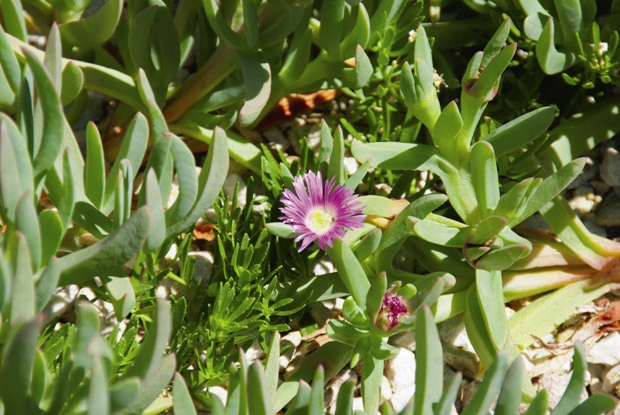
Green roof types
Green roofs vary widely, but can be grouped into three broad classifications according to the thickness of the substrate or growing medium. Extensive roofs have a substrate depth of 150 mm or less, while intensive roofs have a depth greater than 150 mm. Extensive systems are lightweight with low growing plants and are usually not accessible for human use, while intensive systems have better insulation properties and stormwater management, and provide greater biodiversity opportunities. Intensive green roofs can be designed for people to use as recreation spaces, for vegetable gardening and other interactions with the natural environment. Elevated landscapes with substrate depth of 600 mm or greater create a new ground plane, where deeper rooted trees can thrive, and they have even greater insulation and stormwater management benefits. Elevated landscapes are ideally located over infrastructure such as underground parking stations, transport interchanges and railway/road corridors to provide new public open space.
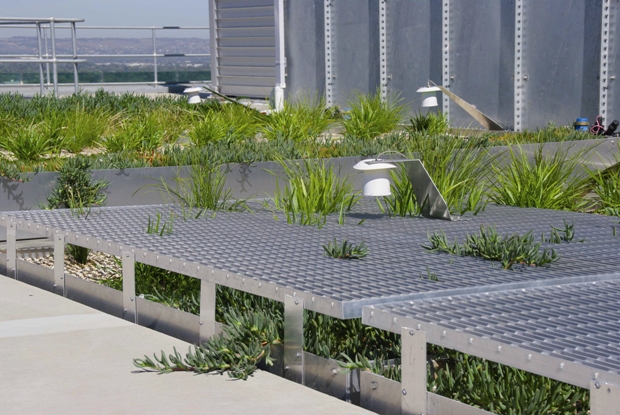
Design considerations
When desiging a green roof several factors need to be considered: the intended type of green roof system, structural considerations of the existing or new structure, the planting or ecosystem proposed, local climate, orientation, green roof functions and maintenance.
Each green roof should be designed to suit its particular context, however, it is important that a good quality waterproof membrane is used over the structural roofing system, together with an effective drainage layer. This is especially important when retrofitting to an existing roof structure. A leak detection system can be installed with the waterproof membrane, which serves as a good risk management program. These systems can identify the precise location of any leak so that timely repairs can be made with minimal disturbance.
Substrates vary from extensive systems weighing as little as 75 kg per sqm through to heavier inorganic, manufactured growing media. Retrofitting a green roof to an existing building requires special attention to structural issues of the building and roof. Providing the structural capacity is approved by a structural engineer and is to BCA standards, green roofs can be installed on concrete slab roofs or metal deck roofs. With intensive green roofs, the heaviest loads should be located over structural supports such as columns or walls, with thinner substrates located at the midspan of the concrete slab or metal deck. The flexibility of green roofs opens up many possibilities, given that our cities feature large areas of metal deck roofs that could be greened.
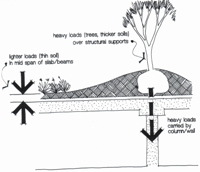
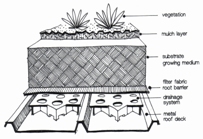

Current research
A current research project by Fifth Creek Studio seeks to quantify some of the benefits of green roofs. The 12 month project is funded jointly by the South Australian Government's Building Innovation Fund and Aspen Developments, with the University of Adelaide and University of South Australia engaged on various aspects of the project. The project involves monitoring thermal performance, water quality and useage, and plant performance characteristics of extensive and intensive green roof beds on the 22nd level rooftop of ANZ House in Adelaide, installed with the permission of ANZ House owners Colonial First State. The incorporation of a trafficable grating over part of the beds is being assessed for potential creation of beneficial micro climates. The trial period is yet to be completed, however, some preliminary findings are emerging.
Thermal performance is being monitored with sensors throughout the substrate profile as well as at the leaf surface and above the plants for ambient air temperatures. This is being compared to a control sensor on the existing concrete roof. This control surface experienced temperatures up to 50oC during summer, whereas the temperatures below the green roofs were down to as low as 26oC at the same time. This data will be used to develop an insulation value, or possibly an R-Value, for various green roof systems suitable for Adelaide's hot, dry climate.
It is important to realise that lowering roof temperatures with green roofs has many beneficial aspects beside the obvious insulation benefit. The building roof components remain at a constant temperature, therefore there is less movement and stress, especially on joints, and given the changing climate with higher temperatures this will be an important consideration in the future.
The development of an extensive green roof system with a trafficable mesh layer above the plants is showing great potential for insulation and plant performance in Adelaide's climate. This will lead to a lightweight, economic system that can be incorporated into the building services plant area on top of buildings to reduce running costs of the building and its CO2 footprint.
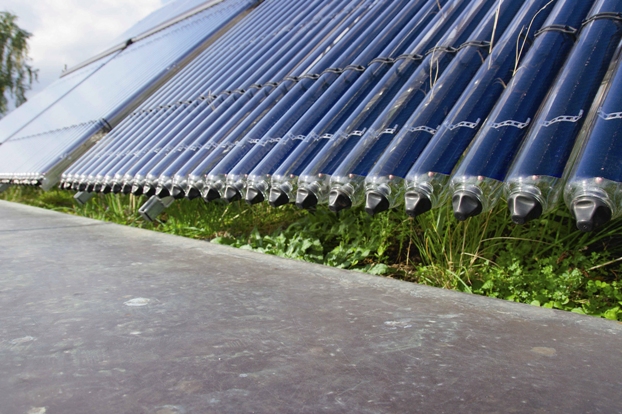
Future growth
Green roofs are important for cities now and in the future, as they create new biomass within the built environment, and also provide new open space as a counterpoint to urban density. A 3D open space system can be created where green roofs are linked to existing ground level parks and open space to provide multi-layered connections between people and the natural environment. Green roofs, as part of a living architecture, can play a vital role in mitigating the effects of a changing climate and other intensities of our city environments.
Graeme Hopkins and Christine Goodwin are directors of Fifth Creek Studio and the authors of Living Architecture: Green roofs and walls, CSIRO Publishing, 2011.

